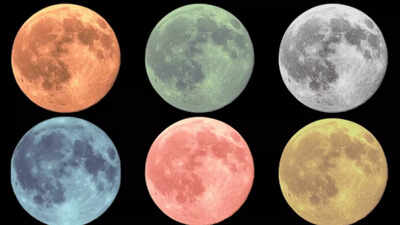Why we see different colours in moonlight — from blood red to honey yellow |

Moonlight has long inspired poets, scientists, and stargazers alike. Though the Moon appears to shine with a silvery glow, its Colour can change dramatically depending on when and where we see it. From a pale white high in the sky to rich oranges near the horizon, or even eerie reds during a lunar eclipse, moonlight is far from a static hue. In reality, the Moon doesn’t emit its own light at all. It reflects sunlight, and what we perceive from Earth depends on complex interactions between that reflected light and our planet’s atmosphere, as well as occasional natural events like wildfires or volcanic eruptions.
How moonlight begins: Reflected sunlight from a rocky surface
What we call moonlight is actually sunlight reflected off the Moon’s rocky surface. The Moon is covered in mostly light-gray rock called anorthosite, mixed with darker basalt in some regions. These materials reflect a wide range of visible wavelengths, producing a generally neutral white light. From space, this reflected light would appear whitish or gray. However, what we see from Earth is often altered by the medium it travels through—our atmosphere—before it reaches our eyes.
Atmospheric filtering: Why the moon turns orange or yellow near the horizon
When the Moon is directly overhead, its light travels a shorter path through the atmosphere, so we see a relatively true, bright white or grayish moonlight. But when the Moon is closer to the horizon, its light has to travel through a much longer stretch of atmosphere. Along the way, shorter wavelengths of light—like blue and violet—are scattered out by molecules of nitrogen and oxygen. This process, called Rayleigh scattering, allows longer wavelengths such as orange, yellow, and red to dominate, making moonlight near the horizon appear more golden or amber in Colour.
Lunar eclipses and the blood moon effect
One of the most dramatic changes in moonlight Colour occurs during a total lunar eclipse. During the eclipse, Earth blocks direct sunlight from reaching the Moon. However, sunlight passing through Earth’s atmosphere is refracted and scattered toward the Moon’s surface. The atmosphere filters out shorter wavelengths, leaving only reds and oranges to reach the Moon. As a result, the Moon takes on a deep reddish hue, earning it the nickname “blood moon.” This same filtering effect is responsible for the red tones we see at sunrise and sunset.
Blue moons caused by particles, not the calendar
While the term “blue moon” usually refers to a rare second full moon in a calendar month, the Moon can sometimes appear truly blue—though it’s extremely rare. After large volcanic eruptions, the atmosphere may become filled with ash particles around one micron in size. These particles can scatter red light and allow more blue wavelengths to reach the observer, giving moonlight a bluish tint. Similarly, certain types of smoke from wildfires can filter out blue light, enhancing red tones and making the Moon appear more orange or crimson.
Honey-coloured moons: A summer phenomenon
In early summer, full moons often appear yellowish or amber-Coloured, giving rise to the term “honey moon.” This is partly due to the Moon’s low angle in the sky during this time of year, which increases the amount of atmosphere the moonlight must pass through. Warmer weather also means there’s more dust, moisture, and pollen in the air, all of which can scatter shorter wavelengths and allow warm tones like yellow and gold to dominate. This subtle yet beautiful transformation has even influenced wedding traditions and folklore.
Rare optical effects: Lunar green flashes and moon halos
Under rare and specific conditions, moonlight can display more unusual Colours and phenomena. When the Moon is very low on the horizon, atmospheric refraction may cause a fleeting “green flash”—a moment when green wavelengths are briefly visible, separated from the rest of the spectrum. Another fascinating effect occurs when high-altitude ice crystals are present in the atmosphere. These can bend and reflect moonlight in such a way that a halo forms around the Moon, sometimes appearing as a rainbow-like ring.
The ever-changing palette of moonlight
Although the Moon itself doesn’t change, the way we perceive its light certainly does. From the gray-white reflection of sunlight to the fiery reds of an eclipse or the warm golds of a honey moon, the Colours of moonlight are shaped by our atmosphere and our viewing conditions. Whether altered by particles, angle, or weather, moonlight remains a vivid reminder that even the most familiar objects in our sky are influenced by Earth’s dynamic environment.






